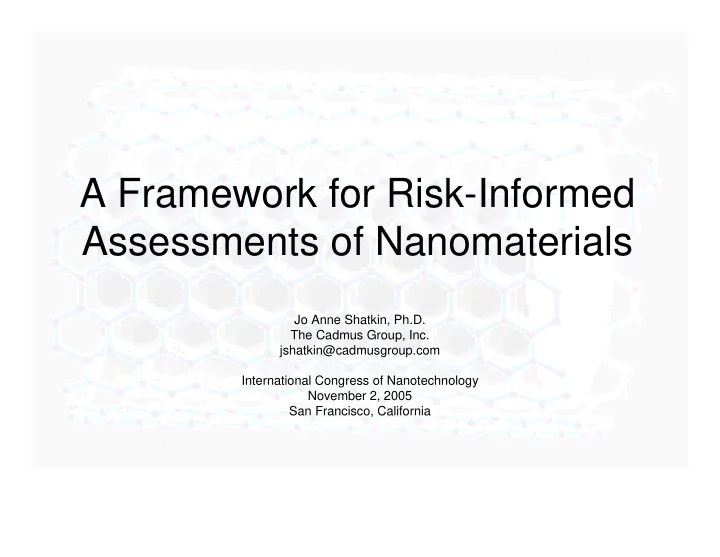

A Framework for Risk-Informed Assessments of Nanomaterials Jo Anne Shatkin, Ph.D. The Cadmus Group, Inc. jshatkin@cadmusgroup.com International Congress of Nanotechnology November 2, 2005 San Francisco, California
Overview • Why be concerned about nanoscale material impacts? • The importance of addressing risks now • Risk assessment: Its not just hazards • Assessing risks of nanoscale materials • Adaptive decision making framework 2 November 2005 jshatkin@cadmusgroup.com 2
Why be concerned about nanomaterial impacts? • Novel properties • History dictates action • Technology advancing quickly • Paucity of information • Potential for wide dispersion in the environment amidst uncertainty • No standards - yet! 2 November 2005 jshatkin@cadmusgroup.com 3
Source: K. Thompson, 2004. 2 November 2005 jshatkin@cadmusgroup.com 4
Commercial Development of Nanotechnology Benefits from Risk Assessment Risk assessment : • Will be the basis for regulatory decision making • Allows decision making under uncertainty • Keeps pace with technology • Prioritizes research directions • Identifies areas for product innovation • Reduces potential for unforeseen impacts 2 November 2005 jshatkin@cadmusgroup.com 5
Assessing risks of nanoscale materials • Identify and characterize hazards • Assess exposure potential • Evaluate toxicity • Characterize risk • Communicate about risks 2 November 2005 jshatkin@cadmusgroup.com 6
Differentiating hazards from risks • All materials are toxic at some concentration • There is no risk if there is no exposure • Risk = hazard * exposure probability 2 November 2005 jshatkin@cadmusgroup.com 7
Adaptive decision framework • A screening tool to identify and prioritize key health and process issues • Dynamic approach applies broadly to array of hazards • Identifies key uncertainties • Revisits early decisions with new information • Applies to health and safety concerns 2 November 2005 jshatkin@cadmusgroup.com 8
Adaptive decision framework • Steps sequentially across processes through product or lifecycle • Evaluates risk at each step • Focuses on exposure potential • Transparent decision framework allows comparison of different products and processes amidst uncertainty • Proactive approach for evaluating safety of novel materials 2 November 2005 jshatkin@cadmusgroup.com 9
ID AND ASSESS EVALUATE CHARACTERIZE EXPOSURE TOXICITY HAZARDS RAW Process PRODUCT Packaging USE MATERIALS CHARACTERIZE RISK MITIGATION MEASURES 2 November 2005 jshatkin@cadmusgroup.com 10
Example SWCNT Fabrication ID and CHARACTERIZE HAZARDS RAW Process PRODUCT Packaging USE MATERIALS 2 November 2005 jshatkin@cadmusgroup.com 11
Nanoparticle Characterization Across Studies Measurement/ Estimate Silica Shvedova, 2005 Ultrafine Carbon black Shvedova, 2005 Particle diameter (nm) CNT by Intratracheal Installation Shvedova, 2005 CNT facility Maynard, 2004 Ambient Air Warheit, 2004 Welding fumes EC 2005 (Möhlmann, 2004) SA(m2/g) [CNT] ug/m3 = estimated NP/cm3 Value 1.E+00 1.E+01 1.E+02 1.E+03 1.E+04 1.E+05 1.E+06 1.E+07 1.E+08 1.E+09 2 November 2005 jshatkin@cadmusgroup.com 12
Example SWCNT Fabrication ASSESS ID HAZARDS EXPOSURE RAW Process PRODUCT Packaging USE MATERIALS 2 November 2005 jshatkin@cadmusgroup.com 13
Exposure Measures of SWCNT (Particles/m3) 1.E+11 Laser Ablation 2 1.E+10 Laser Ablation 1 HiPCO 1 1.E+09 HiPCO 2 1.E+08 # Particles 1.E+07 1.E+06 1.E+05 1.E+04 1.E+03 1.E+02 1.E+01 1.E+00 Chamber Removing Vacuuming CleanUp Entry SWCNT Process Source: Maynard et al. 2004 2 November 2005 jshatkin@cadmusgroup.com 14
Nanoparticle Characterization Across Studies Measurement/ Estimate Silica Shvedova, 2005 Ultrafine Carbon black Shvedova, 2005 Particle diameter (nm) CNT by Intratracheal Installation Shvedova, 2005 CNT facility Maynard, 2004 Ambient Air Warheit, 2004 Welding fumes EC 2005 (Möhlmann, 2004) SA(m2/g) [CNT] ug/m3 = estimated NP/cm3 Value 1.E+00 1.E+01 1.E+02 1.E+03 1.E+04 1.E+05 1.E+06 1.E+07 1.E+08 1.E+09 2 November 2005 jshatkin@cadmusgroup.com 15
Example SWCNT Fabrication ASSESS EVALUATE ID HAZARDS EXPOSURE TOXICITY RAW Process PRODUCT Packaging USE MATERIALS 2 November 2005 jshatkin@cadmusgroup.com 16
Nanoparticle Characterization Across Studies Measurement/ Estimate Silica Shvedova, 2005 Ultrafine Carbon black Shvedova, 2005 Particle diameter (nm) CNT by Intratracheal Installation Shvedova, 2005 CNT facility Maynard, 2004 Ambient Air Warheit, 2004 Welding fumes EC 2005 (Möhlmann, 2004) SA(m2/g) [CNT] ug/m3 = estimated NP/cm3 Value 1.E+00 1.E+01 1.E+02 1.E+03 1.E+04 1.E+05 1.E+06 1.E+07 1.E+08 1.E+09 2 November 2005 jshatkin@cadmusgroup.com 17
Example SWCNT Fabrication ASSESS EVALUATE ID HAZARDS EXPOSURE TOXICITY RAW Process PRODUCT Packaging USE MATERIALS CHARACTERIZE RISK 2 November 2005 jshatkin@cadmusgroup.com 18
Example: SWCNT Single Walled Carbon Nanotubes; packaging Hazard ID: particle diameter, surface area, particle number, concentration. Exposure Assessment: post production handling personal air sample concentrations ranged from 0.001 -0.052 mg/m 3 (Maynard et al., 2004) Toxicity Evaluation: inflammatory responses in lung following intratracheal administration at doses approaching OSHA standard for graphite (5 mg/m 3 ) (Shvedova et al., 2005), but vastly different particle numbers Risk Characterization: toxic responses possible, exposures appear to be orders of magnitude lower; much uncertainty over exposure and toxicity in realm of interest. 2 November 2005 jshatkin@cadmusgroup.com 19
Source: K. Thompson, 2004. 2 November 2005 jshatkin@cadmusgroup.com 20
Recommend
More recommend